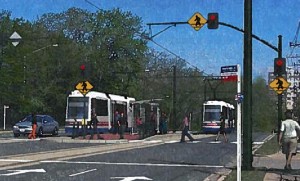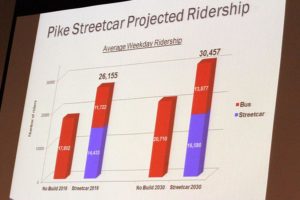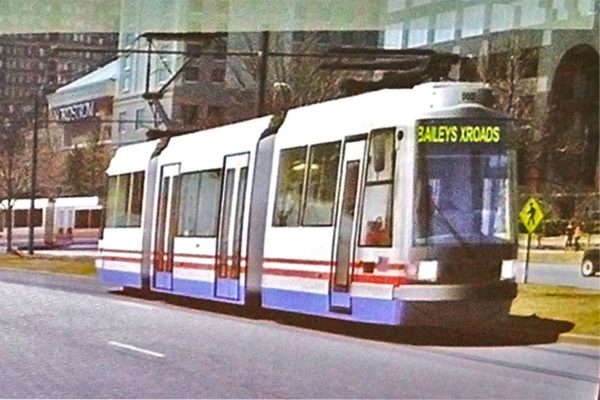Arlington County Board is mulling over possible design specifications of the streetcars that will one day traverse Columbia Pike.
At a work session earlier this month, the Board was presented with a number of streetcar vehicle design considerations, including the width, length, layout and emergency power capacity of the streetcar.
On the topic of streetcar width, Board members seemed to prefer the wider of three options. At 2.65 meters (8 feet and 8 inches), the wider streetcar would be only slightly more broad than the standard Metrobus, at 8 feet and 6 inches. The 2.65 meter streetcar could accommodate four seats and an aisle across, whereas another option, a 2.4 meter streetcar, would only be able to seat three across.
 The wider streetcar would cost roughly the same as the narrower streetcar and would still fit within a 11-foot travel lane along Columbia Pike, the Board was told. A 2.65 meter light rail vehicle is also being considered for Maryland’s Purple Line, opening up the possibility of cost savings through joint purchasing.
The wider streetcar would cost roughly the same as the narrower streetcar and would still fit within a 11-foot travel lane along Columbia Pike, the Board was told. A 2.65 meter light rail vehicle is also being considered for Maryland’s Purple Line, opening up the possibility of cost savings through joint purchasing.
“I don’t know why you’d go with the narrower one,” County Board member Jay Fisette remarked.
Depending on the length and width of the streetcar, each vehicle could have a total capacity of between 92 and 231 riders. A streetcar could thus have three times the capacity of a bus, but with only one driver, lowering operating costs.
While a longer streetcar could seat more riders, the streetscape along Columbia Pike would have to be designed to accommodate the longer length, potentially a daunting task for the longest of streetcar designs. Board member Chris Zimmerman asked Board members to think long-term when they ultimately select a length. He said that ridership will likely increase over time, necessitating higher vehicle capacities. To illustrate the point, he recounted how Metro ran 2- and 4-car trains when it started running in the 70s.
 County staff projects that average weekday streetcar ridership will increase from 14,433 to 16,580 between the system’s first year in operation and 2030. Total Columbia Pike transit ridership in 2016 is projected at 17,802 without the streetcar and 26,155 with the streetcar and buses, rising to 30,457 with streetcars and buses in 2030.
County staff projects that average weekday streetcar ridership will increase from 14,433 to 16,580 between the system’s first year in operation and 2030. Total Columbia Pike transit ridership in 2016 is projected at 17,802 without the streetcar and 26,155 with the streetcar and buses, rising to 30,457 with streetcars and buses in 2030.
Another design consideration has to do with the interior floor layout. Most streetcars have a “partial low floor,” with a low-floor middle section and two end sections with steps leading up to a higher floor, somewhat like current Metrobuses. The higher floor better accommodates the streetcar’s wheels, or running gear. Streetcars can also be built with the low floor throughout the vehicle — like a Metrorail train — but that would raise maintenance costs and possibly make the ride a bit rougher due to a shorter suspension system.
County Board Chair Mary Hynes seemed partial to the “100% low floor” design, since it could better serve parents with strollers, people with bicycles, individuals with disabilities and the elderly.
“We want the street car to be as accessible for as many people as possible,” she said.
A final consideration is how much emergency power storage each streetcar should have. Should a power outage occur, a streetcar without some form of emergency power would simply stop in its tracks.
More emergency power capacity comes at a cost, however, in terms of both vehicle weight and money. County staff is suggesting at least 200 feet worth of “off-wire” travel capacity.
“At minimum, we would want the capability to move the vehicle in emergency circumstances,” said Stephen Del Giudice, Arlington County Transit Bureau Chief.
Board member Walter Tejada asked about the feasibility of using a wireless, completely battery-operated streetcar, but transit consultants who were present at the meeting said that would be impractical for a route as long and hilly as Columbia Pike. Hynes said that the single overhead wire required to power a modern streetcar is much less visible than the overhead wires required by early and mid-20th century streetcars.
“Single wires are not unsightly, like the streetcars of the past,” she said.
Arlington expects to purchase 13 streetcar vehicles to initially run along Columbia Pike, as early as 2016. Each streetcar is expected to cost between $3.5 and $4 million, as compared to between $700,000 and $800,000 for a 40-foot, natural gas-powered Metrobus. Streetcars have an operating life expectancy between 30 and 35 years, compared to about 12 years for a bus.
A Crystal City streetcar line, which will connect to the Columbia Pike line at the Pentagon City Metro station, is also in the works. The Crystal City streetcar line will be designed to use the same streetcar vehicles as the Columbia Pike line.








